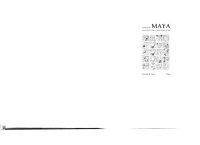
Ebook: Corpus of Maya Hieroglyphic Inscriptions 8.1 (Coba)
Author: Ian Graham Eric von Euw
- Genre: History // American Studies
- Year: 1997
- Publisher: Peabody Museum of Archaeology and Ethnology
- Language: english
- pdf
From its source in Alta Verapaz, the Rio de la Pasion funs northward for about 80 km before changing course abruptly to the west, a course it then follows until it joins the Rio Salinas to form the Usumacinta. For most of the 20 km preceding this bend, the river funs (or crawls, for it is sluggish) along the foot of an escarpment, which reaches its greatest height of about 110 m above the river some 4 km before the bend. It was precisely on this highest ground that the city of Seibal came into being, with its outlying settlements spreading over a broad stretch of terrain to the west, which falls gradually toward the Arroyo Petexbatun.
Until the early 19605 the only known approach to the ruins was from El Ceibal, once a monter/a, or lumber camp (and since then usually the site of a single dwelling), from whence a trail used to lead gently uphill for 4 km to Group A of the ruins. Then in 1961 a Peabody Museum reconnaissance party (Adams 1963) opened up the most direct feasible route to the ruins from a river landing. Now one can climb rather strenuously up a ravine that cuts into the escarpment, emerge near the southeast corner of the partial plan reproduced in this work, and follow the path to Group A.
At the beginning of the museum's Seibal Project, the old trail from El Ceibal was widened into some semblance of a roadway, up which all the provisions, water, and equipment were brought in by a four-wheel-drive pickup. Water is always scarce at Seibal, for the "little spring" that Maler mentions (1908, p. 11) has never been found, probably because it has ceased to flow. In 1966 FYDEP, the development agency responsible for Peten, opened a graded road from the town of Sayaxche, 14 km to the west, as far as the Project's camp, which had been built just south of Structure A-24. At the time of writing, this road from Sayaxche remains in good condition as far as the junction with a road leading south to Raxuja and thence to Coban, but the rest of the way to Seibal is often impassable for vehicles during the rainy season.
Until the early 19605 the only known approach to the ruins was from El Ceibal, once a monter/a, or lumber camp (and since then usually the site of a single dwelling), from whence a trail used to lead gently uphill for 4 km to Group A of the ruins. Then in 1961 a Peabody Museum reconnaissance party (Adams 1963) opened up the most direct feasible route to the ruins from a river landing. Now one can climb rather strenuously up a ravine that cuts into the escarpment, emerge near the southeast corner of the partial plan reproduced in this work, and follow the path to Group A.
At the beginning of the museum's Seibal Project, the old trail from El Ceibal was widened into some semblance of a roadway, up which all the provisions, water, and equipment were brought in by a four-wheel-drive pickup. Water is always scarce at Seibal, for the "little spring" that Maler mentions (1908, p. 11) has never been found, probably because it has ceased to flow. In 1966 FYDEP, the development agency responsible for Peten, opened a graded road from the town of Sayaxche, 14 km to the west, as far as the Project's camp, which had been built just south of Structure A-24. At the time of writing, this road from Sayaxche remains in good condition as far as the junction with a road leading south to Raxuja and thence to Coban, but the rest of the way to Seibal is often impassable for vehicles during the rainy season.
Download the book Corpus of Maya Hieroglyphic Inscriptions 8.1 (Coba) for free or read online
Continue reading on any device:

Last viewed books
Related books
{related-news}
Comments (0)